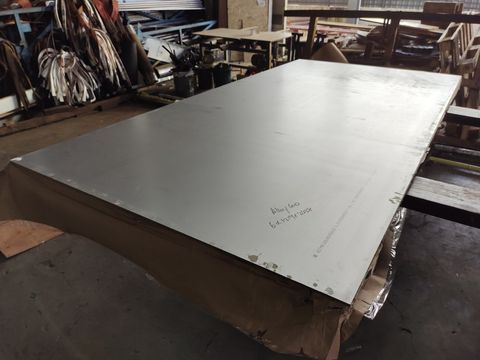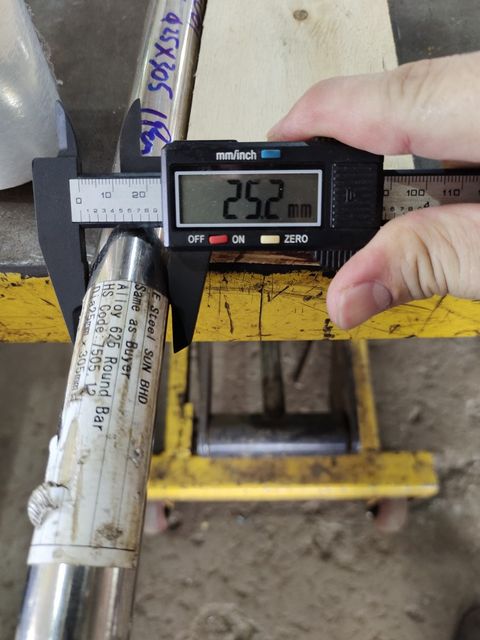Inconel 601 | Nickel Alloy 601 | alloy 601 plate | inconel 601 equivalent | inconel 601 supplier | UNS N06601 | Alloy 601
ราคา:
ขอราคา
We are the Inconel 601 / Nickel Alloy 601 Supplier Malaysia. Inconel 601 is a nickel-chromium-iron alloy with excellent resistance to high-temperature oxidation. A general-purpose material for applications where heat and corrosion resistance are the primary considerations.
Share Product:
รายละเอียด
E Steel Sdn Bhd - A Leading Supplier of Nickel Alloy Inconel 601
INCONEL 601 (or known as Alloy 601)
A nickel-chromium-iron alloy with excellent resistance to high-temperature oxidation. A general purpose material for applications where heat and corrosion resistance are the primary considerations.
Application: A construction alloy for heat treat furnace fixtures and components such as annealing tubes, muffles, flame shields. Also useful for chemical process equipment such as combustor components, process heaters, and condenser tubes.
----------
Chemistry Data :
| Aluminum | 1 – 1.7 |
| Carbon | 0.1 max |
| Chromium | 21 – 25 |
| Copper | 1 max |
| Iron | Balance |
| Manganese | 1 max |
| Nickel | 58 – 63 |
| Silicon | 0.5 max |
| Sulphur | 0.015 max |
| Machinability | Conventional machining techniques used for iron based alloys may be used. This alloy does work-harden during machining and has higher strength and “gumminess” not typical of steels. Heavy duty machining equipment and tooling should be used to minimize chatter or work-hardening of the alloy ahead of the cutting. Most any commercial coolant may be used in the machining operations. Water-base coolants are preferred for high speed operations such as turning, grinding, or milling. Heavy lubricants work best for drilling, tapping, broaching or boring. Turning: Carbide tools are recommended for turning with a continuous cut. High-speed steel tooling should be used for interrupted cuts and for smooth finishing to close tolerance. Tools should have a positive rake angle. Cutting speeds and feeds are in the following ranges: For High-Speed Steel Tools For Carbide Tooling Depth Surface Feed Depth Surface Feed of cut speed in inches of cut speed in inches inches feet/min. per rev. inches feet/min. per rev. 0.250″ 25-35 0.030 0.250″ 150-200 0.020 0.050″ 50-60 0.010 0.050″ 325-375 0.008 Drilling: Steady feed rates must be used to avoid work hardening due to dwelling of the drill on the metal. Rigid set-ups are essential with as short a stub drill as feasible. Heavy-duty, high-speed steel drills with a heavy web are recommended. Feeds vary from 0.0007 inch per rev. for holes of less than 1/16″ diameter, 0.003 inch per rev. for 1/4″ dia., to 0.010 inch per rev. for holes of 7/8″diameter. Milling: To obtain good accuracy and a smooth finish it is essential to have rigid machines and fixtures and sharp cutting tools. High-speed steel cutters such as M-2 or M-10 work best with cutting speeds of 30-40 feet per minute and feed of 0.004″-0.006″ per cutting tooth. Grinding: The alloy should be wet ground and aluminum oxide wheels or belts are preferred. |
| Forming | This alloy has good ductility and may be readily formed by all conventional methods. Because the alloy is stronger than regular steel it requires more powerful equipment to accomplish forming. Heavy-duty lubricants should be used during cold forming. It is essential to thoroughly clean the part of all traces of lubricant after forming as embrittlement of the alloy may occur at high temperatures if lubricant is left on. |
| Welding | The commonly used welding methods work well with this alloy. Matching alloy filler metal should be used. If matching alloy is not available then the nearest alloy richer in the essential chemistry (Ni, Co, Cr, Mo) should be used. All weld beads should be slightly convex. It is not necessary to use preheating. Surfaces to be welded must be clean and free from oil, paint or crayon marking. The cleaned area should extend at least 2″ beyond either side of a welded joint. Gas-Tungsten Arc Welding: DC straight polarity (electrode negative) is recommended. Keep as short an arc length as possible and use care to keep the hot end of filler metal always within the protective atmosphere. Shielded Metal-Arc Welding: Electrodes should be kept in dry storage and if moisture has been picked up the electrodes should be baked at 600 F for one hour to insure dryness. Current settings vary from 60 amps for thin material (0.062″ thick) up to 140 amps for material of 1/2″ and thicker. It is best to weave the electrode slightly as this alloy weld metal does not tend to spread. Cleaning of slag is done with a wire brush (hand or powered). Complete removal of all slag is very important before successive weld passes and also after final welding. Gas Metal-Arc Welding: Reverse-polarity DC should be used and best results are obtained with the welding gun at 90 degrees to the joint. For Short-Circuiting-Transfer GMAW a typical voltage is 20- 23 with a current of 110-130 amps and a wire feed of 250-275 inches per minute. For Spray-Transfer GMAW voltage of 26 to 33 and current in the range of 175-300 amps with wire feed rate of 200-350 inches per minute are typical. Submerged-Arc Welding: Matching filler metal, the same as for GMAW, should be used. DC current with either reverse or straight polarity may be used. Convex weld beads are preferred. |
| Heat Treatment | The alloy is not hardened or strengthened by heat treatment. |
| Forging | Forging should be done in the temperature range of 2250 F to 1900 F. |
| Hot Working | Hot work in the range of 2250 F to 1600 F. Avoid working in the range of 1400 F to 1000 F as the alloy is apt to thermal crack in that region. |
| Cold Working | Cold forming may be done using standard tooling although plain carbon tool steels are not recommended for forming as they tend to produce galling. Soft die materials (bronze, zinc alloys, etc.) minimize galling and produce good finishes, but die life is somewhat short. For long production runs the alloy tool steels ( D-2, D-3) and high-speed steels (T-1, M-2, M-10) give good results especially if hard chromium plated to reduce galling. Tooling should be such as to allow for liberal clearances and radii. Heavy duty lubricants should be used to minimize galling in all forming operations. Bending of sheet or plate through 180 degrees is generally limited to a bend radius of 1 T for material up to 1/8″ thick and 2 T for material thicker than 1/8″. |
| Annealing | Annealing following cold working may be necessary. The annealing temperature is 2100 F and the alloy should be rapidly cooled through the range of 1400 to 1000 F to avoid thermal cracking. |
| Hardening | The alloy hardens by cold working only. |
Physical Data : [top]
| Density (lb / cu. in.) | 0.293 |
| Specific Gravity | 8.11 |
| Specific Heat (Btu/lb/Deg F – [32-212 Deg F]) | 0.107 |
| Electrical Resistivity (microhm-cm (at 68 Deg F)) | 710 |
| Melting Point (Deg F) | 2460 |
| Thermal Conductivity | 87 |
| Mean Coeff Thermal Expansion | 7.6 |
| Magnetic Permeability | 1.003 |
| Modulus of Elasticity Tension | 29.95 |
ข้อมูลจำเพาะ
| คำสำคัญ | |
| แหล่งที่มา | JP |
แคตตาล็อก Download

